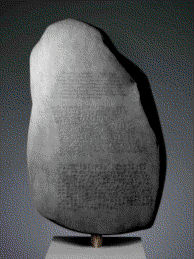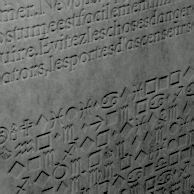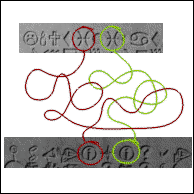A huge slab of carved gabbro discovered in Crombol on the Heath could be the key to deciphering the famously cryptic computer font Wingdings once and for all.

The tablet was excavated by archaeologists working in the grounds of a pig killing factory. The dig was prompted after local metal detectorists uncovered a set of leg hammers and brain drills weeks earlier, suggesting that this site may once have housed an even older and even more violent pig killing factory.
Readers using a Hilltech 15⅔ kbit/s Modem can see a hyper-resolution webscan of the stone by clicking here. When you have finished, please close the page so the next user can look at it.
Once uncovered, the providence of the filthy rock was missed by site lead Mark Hunderson, who was, in his defence, “a bit drunk at the time”. Mistaken for a low-to-middle grade kitchen countertop, it was hoiked into a skip. It was here that passing historian and upstart John Young noticed the remarkable engraving engraved on the obverse. [Obverse? What’s that mean? The front? Just say the front then – Ed.]
Painstakingly carved onto the polished surface are three inscriptions – the first, unhelpfully, is in French, and is presumably complete nonsense. The third is Webdings, a commonly used typeface, and easily decipherable. The second made Young shock a gasp in his mouth when he first saw it. It is unmistakeably Wingdings.
Wingdings has long been regarded a “dead font”. When used, letters typed on the keyboard are converted to baffling eldrich shapes. Just gazing upon them can make a grown man go mad and stomp around the garden for a bit. There exist many artefacts which feature Wingdings writing, but despite many attempts, no one had any idea how to work out what they said.

Young believes that the three pieces of text are not only related, but identical, which is stupid because they clearly look different. Researchers from St Vasey’s College, Oxford, are currently investigating this hypothesis, and have plugged several computers into it to try and decode it but they all broke.
In the end, it was a local schoolboy, whose name will not be shared for data protection reasons, who made the first breakthrough. Simon Kendall, 11, saw a photograph of the stone shared on the College Twitter feed, presumably because he’s a massive swot, and tediously messaged the head of the archaeology department with his pathetic idea.
“It came to me when I saw what could only be described a Black Lozange shape in the Wingdings section, appearing in the same density and proliferation pattern as the Diesel Locomotive in the Webdings extract”, said Kendall, who had a squeaky voice and no mates.

“This to me suggests that they represent the same letter. My hypothesis was further reinforced when I realised that all Lower Right Shadowed White Circles corresponded one-to-one to Men in Business Suits Levitating.”
So far, almost five Wingdings characters have been cracked, and researchers believe that they will have solved another three within our lifetimes. Whatever this means for the future of Wingdings decipherment, the discovery of this relic has certainly put Crombol on the Heath back in the headlines – and not because of the lye poisonings this time!



